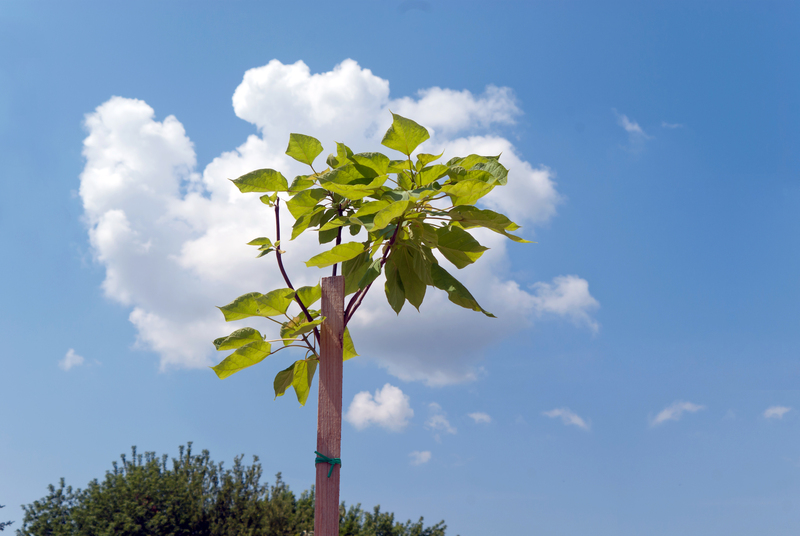The Eco-Force of Gardening Against Climate Change
Posted on 11/06/2025
The Eco-Force of Gardening Against Climate Change
Climate change is one of the greatest challenges facing humanity today, impacting everything from food production to health and biodiversity. Amid global efforts to reduce emissions and restore natural habitats, an unexpected hero has emerged--gardening. In this comprehensive article, we'll explore how eco-friendly gardening can become a powerful force in the fight against climate change, providing practical strategies, key benefits, and actionable steps for gardeners of all levels.
Understanding the Link: How Gardening Influences Climate Change
When we think of battling climate change, we often picture large-scale policies and international agreements. But the collective actions of individuals in their own gardens can add up to significant environmental benefits. Here's how gardening makes a difference:
- Carbon Sequestration: Plants absorb carbon dioxide (CO2) during photosynthesis, helping to reduce greenhouse gases in the atmosphere.
- Biodiversity Support: Gardens provide habitats for pollinators, birds, and beneficial insects, which strengthens ecosystem resilience.
- Soil Health: Sustainable gardening practices improve soil structure and increase its ability to store carbon.
- Reduced Urban Heat: Green spaces lower local temperatures, combating the urban heat island effect.
- Local Food Production: Growing your own vegetables reduces food miles and the carbon footprint of transportation.

Key Strategies: Gardening for a Greener Planet
To maximize the eco-impact of gardening against climate change, it's essential to adopt specific sustainable practices. Below are some practical strategies you can implement in your garden to make a tangible difference:
1. Choose Native and Climate-Resilient Plants
Selecting plants native to your region or those adapted to changing climate conditions can significantly enhance the resilience and sustainability of your garden. Native plants require less water, fertilizer, and maintenance, reducing the energy and resources needed to keep your landscape healthy.
- Research local plant species with deep roots for improved carbon storage.
- Consider drought-tolerant and heat-resistant varieties as climate patterns shift.
2. Practice Regenerative Soil Management
Healthy soil is the foundation of an eco-friendly garden and a potent weapon in the fight against climate change. Soil stores more carbon than the atmosphere and vegetation combined.
Methods to boost soil health include:- Composting: Recycle garden and kitchen waste into nutrient-rich compost to feed your soil and capture carbon.
- No-dig Gardening: Minimize soil disturbance to preserve soil structure and beneficial microbes that help lock away carbon.
- Mulching: Use organic mulch for moisture retention, weed suppression, and slow-release of nutrients.
3. Create Pollinator-Friendly Habitats
Pollinators such as bees, butterflies, and even bats play a crucial role in supporting plant diversity and food production. Climate change poses a serious threat to these creatures, but gardens can serve as important refuges.
- Plant a variety of flowering plants that bloom at different times to provide food all season long.
- Avoid chemical pesticides--opt for natural pest control methods and companion planting.
- Include features like wildflower meadows, hedges, and water sources.
4. Collect and Conserve Water
With increasingly common droughts and fluctuating rainfall due to global warming, water conservation is crucial. Smart water practices reduce strain on municipal resources and help buffer your garden against extreme conditions.
- Harvest rainwater: Install barrels or tanks to collect rain for irrigation.
- Drip Irrigation: Use efficient systems that minimize evaporation and deliver water directly to roots.
- Swales and Rain Gardens: Landscape to capture runoff and promote groundwater recharge.
5. Grow Your Own Food Sustainably
The carbon footprint of food includes emissions from transportation, packaging, and refrigeration. By growing fruits, herbs, and vegetables at home, you cut down on these emissions and gain access to fresher, healthier produce.
- Start a small vegetable patch or container garden, even in limited spaces.
- Choose heirloom and open-pollinated varieties for seed saving and biodiversity.
- Practice crop rotation and intercropping to maintain soil health naturally.
Major Environmental Benefits of Eco-Force Gardening
Embracing the eco-force of gardening does more than beautify your surroundings--it delivers widespread planet-friendly benefits:
- Improved Air Quality: Plants filter pollutants and particulates from the air, making urban areas healthier.
- Increased Resilience: Biodiverse gardens bounce back from pests, disease, and extreme weather more easily.
- Reduced Flood Risk: Gardens with permeable surfaces slow down stormwater runoff, lowering the risk of local flooding.
- Enhanced Physical and Mental Wellbeing: Gardening is linked to lower stress, better fitness, and stronger community ties--fostered by shared, sustainable goals.
Overcoming Challenges: Making Your Gardening Truly Climate Positive
While gardening holds immense potential, it's critical to recognize and avoid certain pitfalls that can undermine climate benefits. Consider these common challenges and how to address them:
- Peat Use: Peat extraction releases large amounts of stored carbon. Always use peat-free composts.
- Plastic Waste: Opt for biodegradable pots, use recycled materials, and avoid single-use plastics in the garden.
- Non-native Invasive Species: Some ornamental plants can become invasive, disrupting local ecosystems. Always check before introducing new species.
- Excessive Fertilizer and Pesticides: Synthetic chemicals can degrade soil, pollute water, and contribute to greenhouse gas emissions. Use organic methods instead.
- Poor Water Management: Overwatering or inefficient irrigation wastes resources; invest in water-smart solutions.
Gardening Innovations for a Changing Climate
As the climate crisis intensifies, new gardening trends and technologies are emerging to maximize gardens' positive environmental impact. Some noteworthy innovations include:
Vertical and Rooftop Gardens
Urban spaces are increasingly turning to vertical or rooftop gardening to expand green spaces where land is scarce. These systems:
- Absorb CO2 and pollutants
- Reduce building energy usage by providing insulation
- Mitigate city heat and support urban wildlife
Permaculture Principles
Permaculture design mimics natural systems to create regenerative, sustainable landscapes:
- Integrates plants, animals, water, and people for efficient resource use
- Encourages perennial crops, polycultures, and closed-loop systems
Smart Gardening Technology
Modern tech is helping gardeners save resources and manage their eco-impact:
- Soil sensors and weather stations for precise irrigation and fertilization
- Solar-powered garden tools and lighting
- Online platforms to share resources, seeds, and knowledge
Community Gardening and Urban Farming
Collective gardening projects transform vacant lots, roofs, and walls into productive green spaces that strengthen food security and social connections while reducing each participant's carbon footprint.
Simple Steps to Start Your Climate-Positive Garden
Everyone can play a role in climate action through gardening. Here's a checklist to get started on your eco-force gardening journey:
- Analyze your site: Study sunlight, soil, water flow, and local flora/fauna before designing your garden.
- Plan for diversity: Incorporate a mix of native trees, shrubs, flowers, and food plants.
- Compost and mulch: Start composting organic waste and apply mulch for healthier, water-wise gardens.
- Reduce, reuse, recycle: Use reclaimed materials for beds, supports, and pathways.
- Engage and learn: Join community groups, workshops, or online forums dedicated to sustainable gardening.
The Future of Eco-Force Gardening
The gardener's role in climate resilience is only set to grow in the coming decades. Worldwide, home gardeners and professionals alike are recognizing the immense value of mindful gardening--and its power to reverse environmental harm. As knowledge, tools, and resources become more accessible, it's increasingly feasible for anyone to contribute to a healthier planet from their own backyard.
By nurturing plants, soil, and biodiversity, gardeners are truly at the frontline of a greener future. Together, we can harness the collective eco-force of gardens--one plot at a time--to combat climate change and cultivate hope for generations to come.

Frequently Asked Questions: Eco-Friendly Gardening and Climate Change
How much carbon can gardening offset?
The precise amount varies, but an average tree can sequester up to 48 pounds of CO2 per year, while soil rich in organic matter can store even more. The more biologically active and diverse your garden, the greater its capacity as a carbon sink.
Can small urban gardens really make a difference?
Absolutely. While individual contributions may seem modest, the cumulative effect of millions of city gardens adds up. Urban green spaces are vital for cooling cities, supporting wildlife, and promoting sustainable local food.
What are the best plants for climate-positive gardening?
Focus on native trees and shrubs, perennial vegetables, and deep-rooted grasses. Avoid fast-growing exotics unless they're proven non-invasive and beneficial to your local ecosystem.
What's the simplest step for a beginner to help the environment?
Start composting your organic kitchen and garden waste. This reduces methane emissions from landfills and creates the foundation for healthy, carbon-rich soil.
Is it possible to garden sustainably without access to a backyard?
Definitely--try balcony container gardening, join a community garden, or volunteer with urban farming initiatives. Windowsill herbs, vertical gardens, and rooftop pots all contribute to urban greening.
Conclusion: Unleashing the Eco-Force of Gardening in a Warming World
From sequestering carbon to providing habitats and growing local food, gardening is a grassroots solution to climate change that is accessible, rewarding, and critically important. Whether you have a sprawling yard or a window box, your actions matter. By embracing the principles and practices outlined above, you can join a global movement turning small green spaces into vital allies in the fight against climate change.
Start today--cultivate your eco-force, grow for the climate, and inspire others to do the same!

